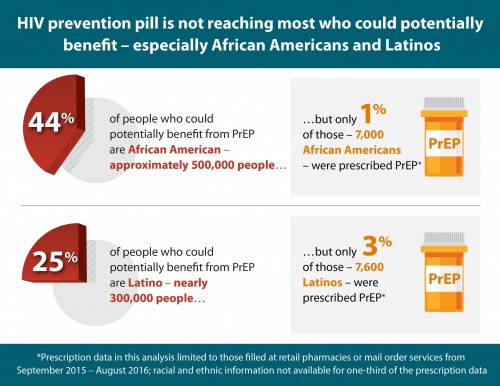Only a slight fraction of the Black and Latinos who would likely stand to benefit from Truvada (tenofovir disoproxil fumarate/emtricitabine) as pre-exposure prophylaxis (PrEP) are actually taking the HIV prevention method, according to a new analysis from Centers for Disease Control and Prevention (CDC) researchers, who have revised their previous estimates of how many U.S. residents are good PrEP candidates.
Numerous data sets and analyses have in recent years joined an ongoing drumbeat warning that a downside of PrEP is that it is poised to widen existing racial disparities in HIV infection rates. Put simply, while Truvada as prevention for the virus has increasingly caught on among white MSM older than 25, racial minorities and in particular younger individuals are largely not getting on the bandwagon.
Epidemiologist Dawn K. Smith, MD, PhD, a medical officer in the CDC’s Division of HIV/AIDS Prevention, presented findings from the new analysis at the 2018 Conference on Retroviruses and Opportunistic Infections (CROI) in Boston.

The CDC’s Dawn Smith speaks at CROI 2018 in Boston.Benjamin Ryan
Smith and her colleagues estimated that 1,145,000 U.S. residents are good PrEP candidates according to CDC guidelines, compared with a previous estimate of 1,232,000 people that was based on what likely were less reliable statistical methods.
Recent research from outside the CDC has suggested that the agency’s guidelines are actually too narrow when it comes to identifying Black PrEP candidates.
The new CDC estimate gave a much greater share of the PrEP-indication pie to MSM, indicating that 814,000 MSM (71.1 percent), 258,000 high-risk heterosexuals (22.5 percent: of the total, 7.1 percent were male and 15.4 percent were female) and 73,000 people who inject drugs (PWID) (6.3 percent) stood to benefit from PrEP. These figures compared with a respective 492,000 MSM (39.9 percent), 624,000 high-risk heterosexuals (50.6 percent) and 115,000 PWID (9.3 percent) according to the previous estimate.
According to a CDC released at the 2017 CROI in Seattle, 70 percent of the estimated 37,600 new HIV infections in 2014 were among MSM, including 3 percent among MSM who inject drugs, 23 percent were among heterosexuals and 5 percent were among non-MSM PWID.

The CDC’s breakdown of estimated new HIV infections in 2014Courtesy of CDC
Of the MSM indicated for PrEP according to the new CDC estimate, a respective 38 percent, 27.1 percent and 29.3 percent were Black, Latino and white, respectively. The corresponding respective figures for high-risk heterosexuals were 63.8 percent, 18 percent and 14.2 percent. The corresponding respective figures for PWID were 36.5 percent, 20.6 percent and 38.6 percent.
All told, 500,340 (43.7 percent) of those indicated for PrEP were Black, 282,260 (24.7 percent) were Latino and 303,230 (26.5 percent) were white. According to data from U.S. retail pharmacies, which process an estimated 85 percent of all PrEP prescriptions, just 7,000 and 7,600 Black and Latinos filled Truvada as prevention prescriptions between September 2015 and August 2016. (These data are further limited by the fact that racial data were not available for one third of the prescriptions.)
During that period, an estimated 14 percent of white, 3 percent of Latino, 1 percent of Black and 8 percent of all individuals indicated for PrEP were estimated to have received it through such pharmacies.

Source: CDC

African-Americans who are likely good PrEP candidates are heavily concentrated in the South, where PrEP access tends to be the weakest compared to the need.Source: CDC
Breaking down the figures by region and race, the CDC estimated that PrEP use among those indicated for Truvada as prevention is greatest among whites living in the Northeast; 28 percent of that group apparently received Truvada during the specified period. Coverage was close to nil among Blacks in the South in particular.

This graph concerns all people who are indicated for PrEP use, not just one subgroup, such as MSM.Source: CDC
The CDC’s new method of coming up with these estimates will allow the agency to produce state-by-state estimates of PrEP indication and use. The release of such data is forthcoming.
To read a press release about the analysis, click here.







Comments
Comments